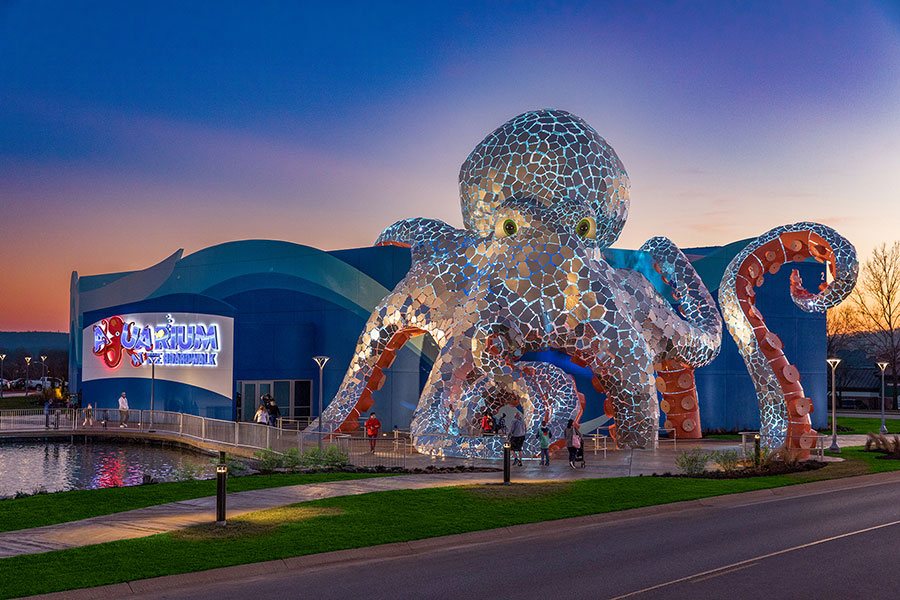Controls make the experience at a new vacation-town attractionBy Michele Zimmerman
Photo: Branson Aquarium
The sun is shining and you’re waiting in line to enter Branson, MO’s Aquarium at The Boardwalk. A 30-ft tall octopus greets you before you walk through the doors and step into a “submarine.” You dive into the deep, discover a shipwreck, swim through a tunnel into a mermaid palace—and you’re just getting started. On you go to find infinite jellyfish, an ocean kaleidoscope, a climbable kelp forest and tide pools. At least, that’s the story arc of this newly opened attraction that’s more theme park than science-focused aquarium—you go on a journey from the heart of the ocean, back up to the shallows.
After the project owners, Kuvera Partners, polled the public on what was missing in Branson—a popular family vacation spot full-to-the-brim with live shows, themed attractions and outdoor activities—it became clear that the only thing absent was an aquarium. To match the Ozark town’s other over-the-top adventures, this aquarium had to provide an experience like no other. “One of my favorite things about this project was that the owners, in a very rare turn, were constantly pushing for more creativity and bigger ideas,” says one of the lead lighting designers, Michael J. Schrupp, EXP.
The attraction opened to the public in November 2020, but the design firm began the work for the complex project, with an even more complex control system, in April 2018.
All of the show elements, a sunrise/sunset husbandry system, color-changing tank lights (Griven USA), wave projectors, gobo projectors (Gantom) and more were programmed into a DMX system with AV integration. Schrupp says, “The best way I can describe [the control system] is as its own little theme park, because each vignette had a different theme and show element that required the lighting to react in a different way.” Many areas, like the climbable “kelp forest,” Kaleidoscope rooms and “Jelly” rooms, are set to a regular regimen of color changes, but can also be individually addressed to interact with guests. For example, guests can choose the color of jellyfish tank illumination with the push of a button located at the base of each tank.
The astronomical husbandry system put in place for the well-being of the fish allows for manual control, but is generally preset to automatically turn lights down after the venue closes, and turn lights up in the morning as staff returns. “Fish, like any animal, need to reset their system. The entire cue is about 20 minutes, and it slowly brings all the lights down in the space. All that is left is a single blue shaft of light into the main tank—because even the ocean isn’t pitch black as long as the moon is out. In the morning, about a half-hour before staff arrives, the tanks will brighten; everything starts to come on. It goes from a dark blue to the base color, which is primarily white. The same light intensity shift happens in all the tanks, even if a color shift doesn’t happen in all 36 of the tanks,” says Schrupp. Approximately a mile of DMX cable runs through the space, like track marks on a pirate’s map for buried treasure. Westview Productions (Denver) served as the integrator for the project, connecting all of the final, critical dots to reach the “X” marking the spot—which in this case, is a dynamic experience for people of all ages.
“The aquarium is very Instagrammable. I am not embarrassed to say that [the owners] were very much about Instagrammable moments—it’s a thing. And we created quite a few of them. This is a space where you see people getting proposed to all the time,” says Schrupp. Of the many social-media worthy elements, the one that catches visitors’ attention first is, of course, the massive octopus atop the building. The sculpture, affectionately named Aquarius, was created in collaboration with Demiurge Design LLC (Denver) and is made from a truss framework with stainless steel panels in various finishes. The artists built a sample tentacle and in turn, Schrupp provided the artists with samples of the floodlights, so the team could join forces in figuring out truss and floodlight-clamping positions. “We modeled the whole thing in Rhino 3D, which is hardcore 3D-rendering, and was more complex than the normal programs we have used,” says Schrupp. “It was a complicated challenge, but it turned out really well.”
By day, Aquarius has a glittering, metallic sheen and by night, it glows—cycling slowly through a series of different aquatic colors. Inside the structure, 40 high-powered, rotatable and separately addressed RGBW floodlights (Griven) in two sizes help Aquarius achieve its colorful lantern-like appearance, while eight large, white floodlights around the perimeter of the structure light up the metal panels and add to Aquarius’s already impressive presence.
As if the one octopus wasn’t enough, guests are encouraged throughout their adventure to search for miniature Aquarius structures camouflaged into the walls. Additionally, “the idea is that the control system is designed for future expansion. We left enough space in it so that should the owners choose to expand, [the expansion and Aquarius’s illumination] can all tie in together,” says Schrupp.
Mirrored infinity rooms and interactive pods are just a couple of the other picture-perfect moments in the aquarium. Space Objekt from Singapore was responsible for the attraction’s infinity rooms, while EXP lined metal panels with color-changing pixel tape (ENTTEC), which relied on over eight universes of DMX and used its own separate art processor. Similarly, RGBW tape was used to line the edges of the climbing “kelp pods” made by Luckey Climbers, located in the “Jelly” room. “Then the bare wires were run out of the pods and we connected them through a power/data supply that allowed us to address every pod individually. The pod runs through a normal sequence, but it might also change color as the kids are climbing. Roughly every five minutes something happens and all the pods will [color fade or chase in a fun sequence, too],” says Schrupp. The “normal sequence” for the pods is choreographed illumination set to an original, orchestral score running on loop.
Projections of bubbles and water ripples, pink tones, blue tones—UV light that helps touch-tank creatures pop in color—name it, and it has been programmed into the aquarium. “I feel like the magic comes from having a lot of flexibility” says Schrupp. A flexibility that wouldn’t be possible without a DMX system as intricately detailed as the world under the sea.
https://youtu.be/tynYhhc0jkY
THE DESIGNERS
Rebecca Bonebrake is a lighting designer with EXP and was a lead designer on this project.
Lindsay Dixon is a lighting designer with EXP.
Aram Ebben is a principal of EXP.
Emily Reed is a lighting designer with EXP.
Michael Schrupp is a lighting director with EXP.


